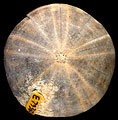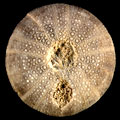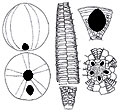The Echinoid Directory
Lanieria Duncan, 1889, p. 158
| Diagnostic Features |
|
|---|---|
| Distribution | Late Cretaceous (Maastrichtian) of Cuba. |
| Name gender | feminine |
| Type | Echinoconus lanieri Cotteau, 1881, p. 11, by monotypy. Figured syntype: BMNH E4570. |
| Species Included |
|
| Classification and/or Status |
|
| Remarks |
|



